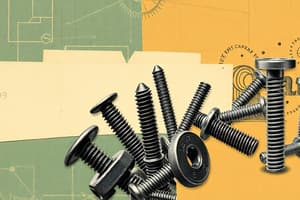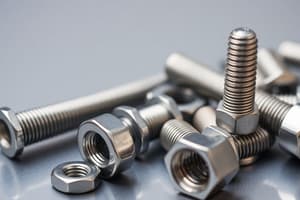Podcast
Questions and Answers
Which of the following standards identifies threaded fasteners and rivets?
Which of the following standards identifies threaded fasteners and rivets?
- ISO
- AN (correct)
- ASTM
- IEEE
What is typically indicated by a Class 4 fit for aircraft fasteners?
What is typically indicated by a Class 4 fit for aircraft fasteners?
- No defined grip length
- Very loose fit
- Easy to turn with fingers
- Use of a wrench required (correct)
What distinguishes a bolt from a screw in terms of threaded section?
What distinguishes a bolt from a screw in terms of threaded section?
- Screws do not have threaded sections.
- Bolts have longer threaded sections.
- Bolts have shorter threaded sections. (correct)
- Both have the same size threaded sections.
Which fastening method provides quicker dismantling for aircraft parts?
Which fastening method provides quicker dismantling for aircraft parts?
What is the primary concern when selecting substitutes for aircraft fasteners?
What is the primary concern when selecting substitutes for aircraft fasteners?
Which of the following is NOT a head style for AN bolts?
Which of the following is NOT a head style for AN bolts?
What class fit are aircraft screws generally manufactured with?
What class fit are aircraft screws generally manufactured with?
What does the letter 'S' stamped on the head of a bolt typically indicate?
What does the letter 'S' stamped on the head of a bolt typically indicate?
What distinguishes AN-type aircraft bolts from other bolts?
What distinguishes AN-type aircraft bolts from other bolts?
Which marking indicates corrosion-resistant steel for AN standard bolts?
Which marking indicates corrosion-resistant steel for AN standard bolts?
What feature distinguishes self-locking nuts from non-self-locking nuts?
What feature distinguishes self-locking nuts from non-self-locking nuts?
What type of nut is specifically designed to accommodate a cotter pin or lockwire?
What type of nut is specifically designed to accommodate a cotter pin or lockwire?
How can NAS bolts be identified differently from AN bolts?
How can NAS bolts be identified differently from AN bolts?
Which bolt is typically used in applications subjected only to shearing stress?
Which bolt is typically used in applications subjected only to shearing stress?
What is a primary characteristic that limits the use of the plain hex nut on aircraft structures?
What is a primary characteristic that limits the use of the plain hex nut on aircraft structures?
What type of bolt marking indicates a standard AN-type bolt?
What type of bolt marking indicates a standard AN-type bolt?
What type of nut must always be secured with an external locking device?
What type of nut must always be secured with an external locking device?
What is the function of color lacquer or distinctive markings on bolts inspected magnetically?
What is the function of color lacquer or distinctive markings on bolts inspected magnetically?
What is the primary purpose of the wing nut, AN350?
What is the primary purpose of the wing nut, AN350?
Under what conditions should self-locking nuts not be used?
Under what conditions should self-locking nuts not be used?
How does the locking mechanism of the Boots self-locking nut function?
How does the locking mechanism of the Boots self-locking nut function?
What are the characteristics of the stainless steel self-locking nut?
What are the characteristics of the stainless steel self-locking nut?
What feature is unique to the Elastic stop nut?
What feature is unique to the Elastic stop nut?
What should be checked before reusing an elastic stop nut?
What should be checked before reusing an elastic stop nut?
Which material is the Rol-top nut made from?
Which material is the Rol-top nut made from?
What is the primary function of the nylon collar in the Elastic stop nut?
What is the primary function of the nylon collar in the Elastic stop nut?
What is necessary for the effective use of self-locking nuts on certificated aircraft?
What is necessary for the effective use of self-locking nuts on certificated aircraft?
What characteristic differentiates the Boots self-locking nut from standard nuts?
What characteristic differentiates the Boots self-locking nut from standard nuts?
How is corrosion-resistant steel indicated on AN standard bolts?
How is corrosion-resistant steel indicated on AN standard bolts?
What is the significant difference between the Castle nut and the Castellated shear nut?
What is the significant difference between the Castle nut and the Castellated shear nut?
Which characteristic distinctly identifies the AN aluminum alloy bolts?
Which characteristic distinctly identifies the AN aluminum alloy bolts?
What type of nuts must be secured by external locking devices?
What type of nuts must be secured by external locking devices?
What marking is used for close tolerance NAS bolts?
What marking is used for close tolerance NAS bolts?
Which of the following is NOT a type associated with non-self-locking nuts?
Which of the following is NOT a type associated with non-self-locking nuts?
What feature must an auxiliary locking device provide when used with the plain hex nut?
What feature must an auxiliary locking device provide when used with the plain hex nut?
How can bolts inspected by magnetic or fluorescent methods be identified?
How can bolts inspected by magnetic or fluorescent methods be identified?
Which type of nut is primarily used for miscellaneous light tension requirements?
Which type of nut is primarily used for miscellaneous light tension requirements?
What must be evident in the construction of self-locking nuts?
What must be evident in the construction of self-locking nuts?
What is the primary reason bolting is preferred over riveting for some aircraft joints?
What is the primary reason bolting is preferred over riveting for some aircraft joints?
What type of fit do aircraft bolts typically use?
What type of fit do aircraft bolts typically use?
Which statement best describes the assembly process of a bolt compared to a screw?
Which statement best describes the assembly process of a bolt compared to a screw?
What precaution should be taken if duplicate aircraft fasteners are unavailable?
What precaution should be taken if duplicate aircraft fasteners are unavailable?
Which distinguishing feature identifies special bolts in aviation?
Which distinguishing feature identifies special bolts in aviation?
How are aircraft screws typically manufactured in terms of fit?
How are aircraft screws typically manufactured in terms of fit?
What is the main purpose of the grip length on bolts compared to screws?
What is the main purpose of the grip length on bolts compared to screws?
Which head style is NOT associated with AN-type bolts?
Which head style is NOT associated with AN-type bolts?
Which class fit allows bolts to be turned easily by fingers?
Which class fit allows bolts to be turned easily by fingers?
What distinguishes a bolt's threaded section length in applications?
What distinguishes a bolt's threaded section length in applications?
What is a specific limitation of using self-locking nuts in applications involving rotation?
What is a specific limitation of using self-locking nuts in applications involving rotation?
Which feature of the Boots self-locking nut enhances its performance under severe vibration?
Which feature of the Boots self-locking nut enhances its performance under severe vibration?
How does the nylon collar in the Elastic stop nut contribute to its locking mechanism?
How does the nylon collar in the Elastic stop nut contribute to its locking mechanism?
What is the mechanism by which the locking action of the stainless steel self-locking nut occurs?
What is the mechanism by which the locking action of the stainless steel self-locking nut occurs?
What material finish is typically associated with the Rol-top nut?
What material finish is typically associated with the Rol-top nut?
What is a common characteristic of the elastic stop nut that enhances its reusable nature?
What is a common characteristic of the elastic stop nut that enhances its reusable nature?
Why is it necessary to ensure that the fibre of the elastic stop nut has not lost its locking friction?
Why is it necessary to ensure that the fibre of the elastic stop nut has not lost its locking friction?
What unique property does the nylon collar in an elastic stop nut possess regarding environmental exposure?
What unique property does the nylon collar in an elastic stop nut possess regarding environmental exposure?
What essential feature must be present for effective use of self-locking nuts on certificated aircraft?
What essential feature must be present for effective use of self-locking nuts on certificated aircraft?
What distinguishes the Elastic stop nut from the other types of self-locking nuts mentioned?
What distinguishes the Elastic stop nut from the other types of self-locking nuts mentioned?
Flashcards
Threaded Fasteners
Threaded Fasteners
These fasteners are used to connect aircraft parts, providing a strong and secure union.
Fastening Devices
Fastening Devices
They ensure that parts can be easily disassembled and reassembled for maintenance.
Bolts and Screws
Bolts and Screws
They are designed to be significantly stronger than rivets, handling high stress and tension.
Bolt Fit Classes
Bolt Fit Classes
Signup and view all the flashcards
Class 4 Fit
Class 4 Fit
Signup and view all the flashcards
Class 3 Medium Fit
Class 3 Medium Fit
Signup and view all the flashcards
AN and NAS Bolts
AN and NAS Bolts
Signup and view all the flashcards
Special Bolts
Special Bolts
Signup and view all the flashcards
AN-type Bolt Identification
AN-type Bolt Identification
Signup and view all the flashcards
AN Standard Steel Bolt Marking
AN Standard Steel Bolt Marking
Signup and view all the flashcards
AN Corrosion-Resistant Steel Bolt Marking
AN Corrosion-Resistant Steel Bolt Marking
Signup and view all the flashcards
AN Aluminum Alloy Bolt Marking
AN Aluminum Alloy Bolt Marking
Signup and view all the flashcards
NAS Bolt Identification
NAS Bolt Identification
Signup and view all the flashcards
Non-self-locking Nuts
Non-self-locking Nuts
Signup and view all the flashcards
Self-locking Nuts
Self-locking Nuts
Signup and view all the flashcards
Castle Nut (AN310)
Castle Nut (AN310)
Signup and view all the flashcards
Castellated Shear Nut (AN320)
Castellated Shear Nut (AN320)
Signup and view all the flashcards
Plain Hex Nut (AN315, AN335)
Plain Hex Nut (AN315, AN335)
Signup and view all the flashcards
Wing Nut (AN350)
Wing Nut (AN350)
Signup and view all the flashcards
Self-Locking Nuts on Certified Aircraft
Self-Locking Nuts on Certified Aircraft
Signup and view all the flashcards
Self-Locking Nuts for Aircraft
Self-Locking Nuts for Aircraft
Signup and view all the flashcards
Avoiding Rotation in Self-Locking Nuts
Avoiding Rotation in Self-Locking Nuts
Signup and view all the flashcards
Boots Self-Locking Nut
Boots Self-Locking Nut
Signup and view all the flashcards
Boots Self-Locking Nut Variations
Boots Self-Locking Nut Variations
Signup and view all the flashcards
Elastic Stop Nut
Elastic Stop Nut
Signup and view all the flashcards
Reusing Elastic Stop Nuts
Reusing Elastic Stop Nuts
Signup and view all the flashcards
Stainless Steel Self-Locking Nut
Stainless Steel Self-Locking Nut
Signup and view all the flashcards
What is a Wing Nut (AN350) designed for?
What is a Wing Nut (AN350) designed for?
Signup and view all the flashcards
What are self-locking nuts?
What are self-locking nuts?
Signup and view all the flashcards
Are self-locking nuts allowed on certified aircraft?
Are self-locking nuts allowed on certified aircraft?
Signup and view all the flashcards
Why are self-locking nuts used on aircraft?
Why are self-locking nuts used on aircraft?
Signup and view all the flashcards
What should be avoided when using self-locking nuts?
What should be avoided when using self-locking nuts?
Signup and view all the flashcards
Describe the construction of a Boots self-locking nut.
Describe the construction of a Boots self-locking nut.
Signup and view all the flashcards
How are Boots self-locking nuts available?
How are Boots self-locking nuts available?
Signup and view all the flashcards
Describe the construction of an Elastic stop nut.
Describe the construction of an Elastic stop nut.
Signup and view all the flashcards
What should be checked when reusing elastic stop nuts?
What should be checked when reusing elastic stop nuts?
Signup and view all the flashcards
How does a stainless steel self-locking nut work?
How does a stainless steel self-locking nut work?
Signup and view all the flashcards
Bolt
Bolt
Signup and view all the flashcards
Screw
Screw
Signup and view all the flashcards
AN Standard Steel Bolt
AN Standard Steel Bolt
Signup and view all the flashcards
AN Corrosion-Resistant Steel Bolt
AN Corrosion-Resistant Steel Bolt
Signup and view all the flashcards
AN Aluminum Alloy Bolt
AN Aluminum Alloy Bolt
Signup and view all the flashcards
NAS Bolt
NAS Bolt
Signup and view all the flashcards
Bolt Identification
Bolt Identification
Signup and view all the flashcards
AN-type Bolt
AN-type Bolt
Signup and view all the flashcards
Standard Steel AN Bolt Marking
Standard Steel AN Bolt Marking
Signup and view all the flashcards
Corrosion-Resistant Steel AN Bolt Marking
Corrosion-Resistant Steel AN Bolt Marking
Signup and view all the flashcards
Aluminum Alloy AN Bolt Marking
Aluminum Alloy AN Bolt Marking
Signup and view all the flashcards
Light Hex Nut (AN340, AN345)
Light Hex Nut (AN340, AN345)
Signup and view all the flashcards
Study Notes
Fasteners: Identification and Types
- Fasteners (threaded and rivets) are identified by AN (Air Force-Navy), NAS (National Aircraft Standard), or MS (Military Standard) numbers.
- Fastening processes must create a joint as strong as the joined parts.
- Alternative fasteners (bolts, screws) allow for easier disassembly and reassembly of aircraft parts without weakening joints. Riveting or welding these parts each time they are serviced would soon weaken or ruin the joint. Some joints require more tensile strength and stiffness than rivets can provide.
- Bolts have a short threaded section and a long unthreaded grip. Screws have a long threaded section and may directly fit the material.
- Bolts are tightened by turning the nut; the bolt head may be designed for turning.
- Screws are tightened by turning their head.
- Replacement fasteners should ideally be identical to the originals. Using like fasteners is important. If duplicates are unavailable, use substitutes with extreme care.
- Fit classes exist: Class 1 (loose), Class 2 (free), Class 3 (medium), and Class 4 (close).
- Aircraft bolts are typically Class 3.
- Class 1 fits can be tightened by hand; Class 4 fits require a wrench. Aircraft screws are usually Class 2 (free) for ease of assembly.
- Special bolts have an "S" stamp on the head.
Bolt Identification
- Bolt identification is based on head shape, securing method, material, and use.
- AN bolts have markings for manufacturer, material, and type (standard or special purpose).
- Standard steel AN bolts have "X" or asterisk markings.
- Corrosion-resistant steel has a single dash.
- Aluminum alloy has two dashes.
- Additional data (diameter, length, grip length) are in the part number.
- NAS bolts have raised or recessed triangles; material markings match AN bolts (raised or recessed).
- Magnatlux or Zyglo inspected bolts have colored lacquer or distinctive head markings.
- Aluminum, brass, or insert nuts are identified by metallic luster/color or construction.
Nuts (Aircraft)
- Nuts are classified as self-locking or non-self-locking.
- Non-self-locking nuts require external locking (cotter pins, wire, locknuts).
- Self-locking nuts have built-in locking mechanisms.
- Common non-self-locking nuts include: plain nuts, castle nuts, castellated shear nuts, plain hex nuts, light hex nuts, plain checknuts, and wing nuts.
- Different nut types (e.g., AN310, AN320, AN315, AN335, AN340, AN345, AN316, AN350) have specific applications and features (e.g., strength, safety features). Spring-loaded "self-locking" nuts maintain tightness despite vibration.
Self-Locking Nuts (Examples)
- Boots self-locking nuts: A two-part design with a spring-loaded locking mechanism for vibration resistance; load-carrying and locking sections. The spring keeps them spaced so bolts thread through the load-carrying section and then push the locking section and engage. Spring exerts continuous tightening force. Load-carrying section has standard thread strength. Three spring styles and various shapes/sizes.
- Rol-top nuts: Cadmium-plated steel.
- Bellows type nuts: Aluminum alloy only.
- Stainless steel self-locking nuts: Use a compression mechanism to lock. Two-part nut: a case with a beveled locking shoulder, and a threaded insert with a locking shoulder and slotted keyway. The locking shoulder gets wedged/compressed and locks bolt, tighten for lock.
- Elastic stop nuts: A standard nut with an added nylon collar. The nylon collar creates downward pressure to lock the nut. Nylon is resistant to water damage. When tightened, friction pushes the nylon, creates downward pressure on the load-carrying part, ensuring positive contact between nut and bolt threads. Aircraft bolts are available in aluminum alloy with anodized finish or cadmium-plated steel. Check that material hasn't become brittle. Use only when able to securely turn.
Studying That Suits You
Use AI to generate personalized quizzes and flashcards to suit your learning preferences.
Description
Explore the different types of fasteners used in aircraft assembly, including threaded fasteners, rivets, bolts, and screws. Learn about identification standards like AN, NAS, and MS, as well as the importance of fit classes and proper replacement practices. This quiz is essential for understanding fastening processes in aerospace applications.



